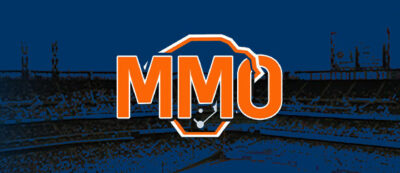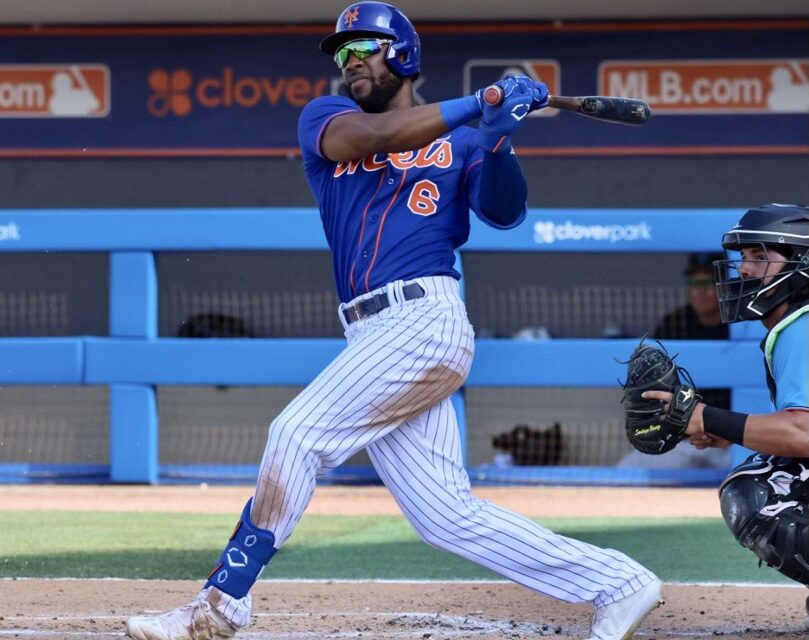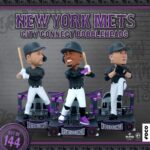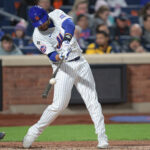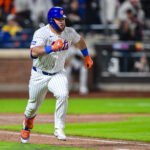
Starling Marte. Photo by Ed Delany, MMO
At 31-35, the New York Mets are in a deep funk that has shocked baseball. A 101-win team in 2022 with World Series aspirations and a $364 million payroll should get better, not worse. Even the loss of Edwín Diaz subtracted a three-win player from 2022 and did not mar the expectations of a championship pursuit.
Forty percent of the way through, though, the Mets look closer to bottom feeders than title contenders. Pretty much everything that could go wrong has done so.
The question is how shocking this really should be. It is far from the first time that a Mets team with big hopes faceplanted. They were counting on everything to go right, and none of it has.
Should we be all that surprised?
Unhealthy Rotation
The Mets relied on five starting pitchers on the wrong side of 30, including two who are 39 or older. Another has consistently struggled with health in recent seasons, and a fourth was coming over from Japan with a questionable physical.
While you don’t expect everything to go wrong simultaneously, it is not all that unusual. Pitching injuries often take a while to heal. With the ages of the Mets’ starters, extended and overlapping absences should have been the baseline expectation.
Justin Verlander‘s time on the injured list was par for the course for an older pitcher, as were Scherzer’s bad neck and Carrasco’s bone spur. José Quintana‘s rib lesion was the only unexpected outcome.
Underachieving Starters
The fact that an older pitcher has defeated Father Time until now is no guarantee that they will continue to do so. Max Scherzer has fallen apart toward the end of the season for several years now. He gave up a combined 11 earned runs in his last two 2022 starts against the Braves and Padres. He had an encouraging five-start stretch but again fell apart against Atlanta.
Verlander, meanwhile, had a successful comeback from Tommy John surgery, winning the Cy Young last year. However, he is also playing with an undefeated opponent. At this point, there is concern that his age has caught up with him. His 4.85 ERA is no longer just the product of a small sample size.
Carrasco struggled against decent-hitting teams last season and is a contact pitcher. He was in the 32nd percentile in hard-hit rate in 2022. His .337 BABIP allowed was a function of that rate, not bad luck. 2022 was also a bounceback year for Carrasco after a disastrous 2021 season. He has had isolated bright moments this season, but a 2021-style collapse should not be shocking.
Kodai Senga has been the Mets’ best starter, which is a scary thought. Senga has a high ceiling when he puts it all together. However, he has a propensity to pile up walks and implode. The Mets knew that his best pitch breaks out of the zone, and they signed him anyway. They are seeing the results, both good and bad.
Tylor Megill‘s performance this year is consistent with what he showed previously. He can be good in pockets, but he has only one plus pitch, his fastball. That’s not enough to be a starting pitcher in the league.
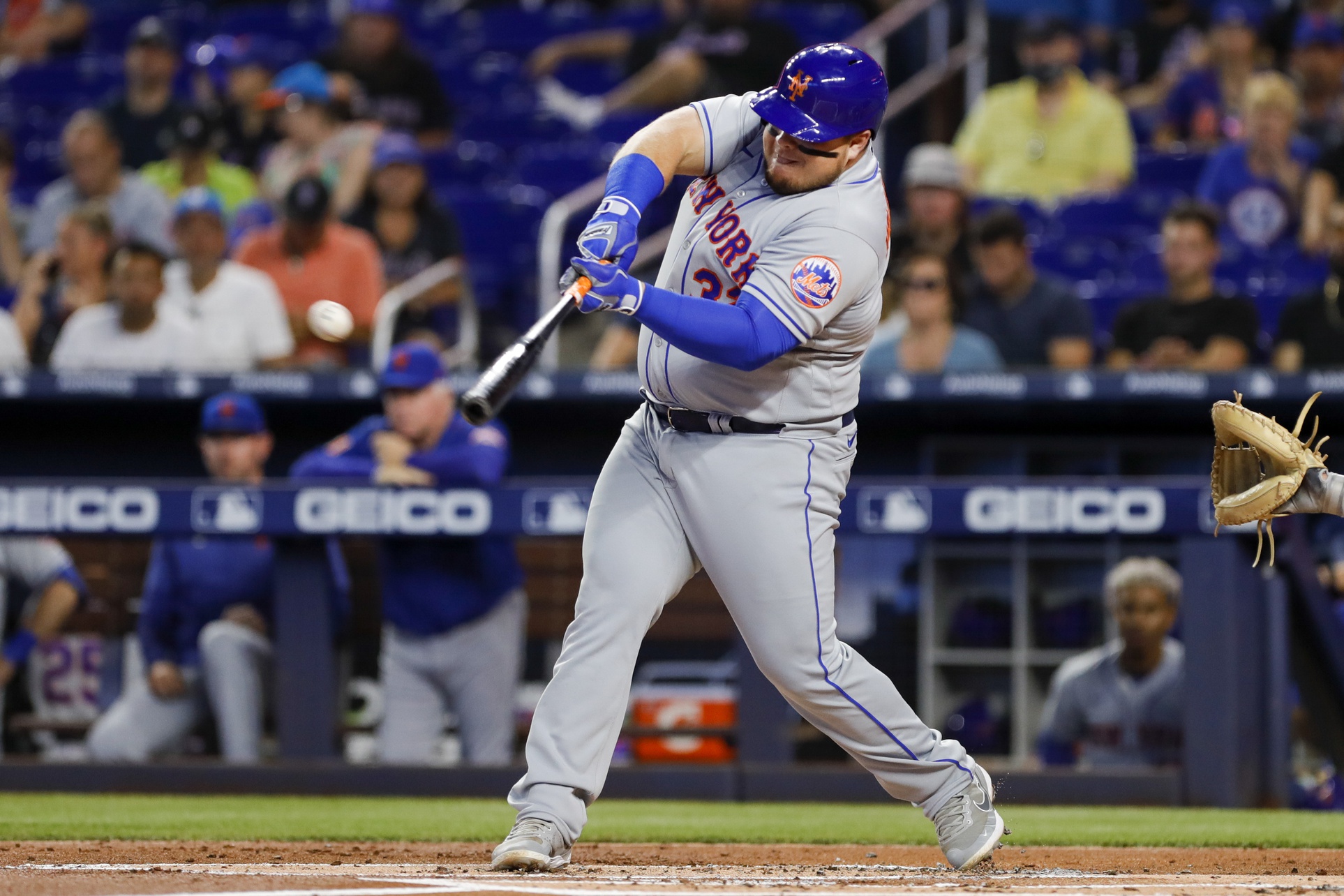
Daniel Vogelbach. Sam Navarro-USA TODAY Sports
Regressing Hitters
Before spring training, I wrote an article about the top five questions facing the Mets heading into 2022. The first was whether the starters could stay healthy, the answer to which was no in the early going. The second was whether the hitters could maintain their 2022 production. I stated that six of the nine hitters in the lineup overperformed last season, whether compared to their career norms or their production the year prior.
So far, the answer to that question, too, is no.
Daniel Vogelbach
When the Mets re-signed Daniel Vogelbach, it seemed like a no-brainer to some. After all, Vogelbach had a 128 wRC+ and a .793 SLG in 2022. What could go wrong?
First, Vogelbach’s lack of versatility was dangerous to carry with Luis Guillorme and Tomás Nido, two defense-only players, already on the roster. Besides, Vogelbach is not even an everyday player. This meant the Mets would need to carry someone else for the other side of the platoon, eating up yet another roster spot.
Beyond that, Vogelbach’s 2022 season was an outlier for most of his career. He had never exceeded a 112 wRC+ before and posted a 102 mark in 2021. Despite his reputation as an on-base percentage king, his .360 mark in 2022 was the highest of his career, up 11 points on his 2021 number of .349. That .360 OBP was not good enough for a player without true DH power.
Vogelbach is unwilling to swing at balls over the plate; he has the lowest zone swing rate in baseball among 327 batters with at least 100 plate appearances at 48.4 percent. He is also the 16th-lowest in meatball swing rate. Having a low chase rate is a small part of plate discipline; a good batting eye entails selecting good pitches to hit and putting effective swings on them. Vogelbach already showed himself to be deficient in this area in 2022.
Vogelbach’s decline to a .203/.343/.297 mark in 2022 may seem astonishing. However, his 2021 mark—.219/.349/.381—should have given the Mets significant pause before committing to him as their primary DH.
Starling Marte
The most obvious candidate for regression was Starling Marte, who had offseason core muscle surgery after suffering an injury-riddled second half of 2022. Marte was the stir for the Mets’ lineup drink last season. They struggled without him at full strength despite posting decent run-scoring averages.
This year, Marte injured his neck on a slide into third base, but his legs have not appeared healthy, either. Despite 18 stolen bases, he is in the 47th percentile in sprint speed, down from the 68th last season. He is slashing .258/.316/.333 (.649 OPS), a far cry from his .292/.347/.468 (.815 OPS) a season ago. His lack of extra-base power has been a loss for the Mets. Marte has just nine extra-base hits in 213 at-bats (4.2 percent rate) after having 45 in 466 at-bats (9.7 percent) in 2022.
Marte was a candidate for regression from the outset due to his age and injuries, which I stated in my article. He has started to show signs of life, but a season-long funk could not be ruled out before the year.
Mark Canha
Mark Canha was another player I suspected might not play as well in 2023 due to his age. While Canha has started to come on of late, hitting .267/.347/.433 over his last 30 games (similar to his .266/.367/.403 line from a year ago), he is still just at .246/.330/.397 for the season. His wRC+ is down from 128 to 105.
Since Canha’s career wRC+ is 117, some regression to the mean was natural. Coupled with age, there is a chance that he could take a more significant dip on a full-year basis when the Mets needed him to replicate his 2022 success.
Francisco Lindor
Francisco Lindor is having another down year. His first two years with the Mets were divided into one strong and one weak. The question was if he could keep up his 2022 progress rather than reverting to his 2021 funk. Considering that he also had a subpar season in 2020, it was a legitimate concern despite his strong career averages. So far in 2023, Lindor’s numbers are mostly worse than his 2020-21 lines.
- 2020: .258/.335/.415/.750, one homer per 33 PA, .324 wOBA, 105 wRC+
- 2021: .230/.322/.412/.735, one homer per 26 PA, .317 wOBA, 103 wRC+
- 2023: .216/.291/.420/.711, one homer per 24 PA, .311 wOBA, 100 wRC+
While this was not necessarily predictable, it was certainly a possibility. That is why I listed Lindor as a concern in my article.
Eduardo Escobar
Billy Eppler’s refusal to acknowledge that Eduardo Escobar struggled for most of 2022 belied what most Mets fans knew: Escobar should not have been the starting third baseman this year. Brett Baty is now struggling as a rookie. Both of these things were highly predictable. Not providing lineup reinforcements to account for that likelihood was a blunder on Eppler’s part.
Jeff McNeil
Jeff McNeil is starting to become a concern, as well. After slashing .326/.382/.454/.836 in 2022, McNeil’s line reads .274/.351/.354/.705. His 102 wRC+ is a far cry from his 143 mark a season ago.
McNeil’s stock in trade is outperforming his expected metrics with a sky-high BABIP despite low hard-hit rates. It’s just .297 this season and was .280 in 2021, while his lowest BABIP in his other four seasons was .335.
After a down year in 2021, there was always the possibility that McNeil could revert to those difficulties once more. This was not predictable, per se, but it did not come totally out of left field.
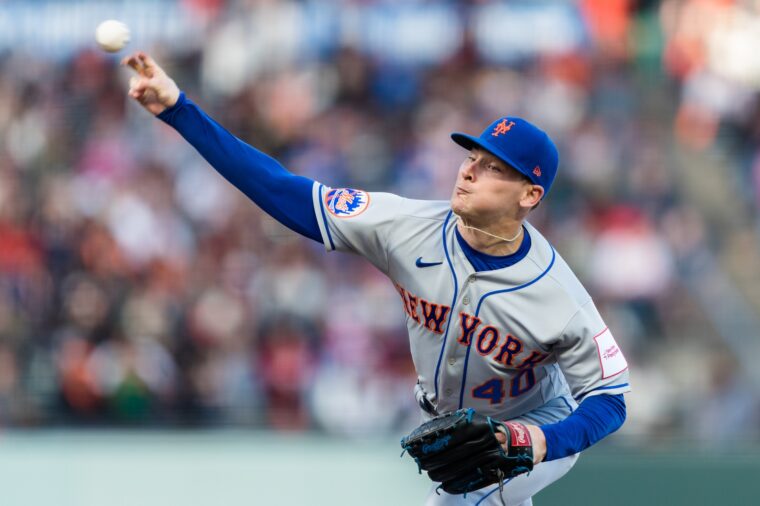
Drew Smith. John Hefti-USA TODAY Sports
Relief Questions
Even before Diaz went down for the season, the Mets had questions about their bullpen. David Robertson, Adam Ottavino, and Brooks Raley were considered reliable options, but all three are 35-plus. That meant both injuries and declining performance were possible.
Once Diaz went down, extra pressure fell on Drew Smith to develop into a quality reliever. But even assuming Smith would perform well, there were other questions beyond him. The remaining names in the Mets’ bullpen included Tommy Hunter, Stephen Nogosek, Dennis Santana, and John Curtiss, none of whom had proven themselves in any way.
There were reasons to believe the Mets’ bullpen could be an issue. After starting relatively okay, they have imploded recently, most notably in the three-game sweep against Atlanta. They rank 22nd in baseball with a 4.34 ERA and have given up the second-most home runs with 38 (one fewer than the Athletics’).
Even Robertson, who started the season strong, has shown cracks due to overuse. Ottavino and Raley have been up and down, while Smith is beginning to struggle mightily. Hunter, Nogosek, and Santana were all designated for assignment. Curtiss was sent down to the minors, only to be recalled due to the struggles of Hunter and Nogosek.
Why are the Mets searching for answers now? Diaz is a part of it, but a bigger part may be Eppler’s insistence on acquiring optionable arms over quality ones. I criticized the notion when the report came out at the time. This was eminently predictable.
Dismal Depth
The Mets started the season with a bench of Tommy Pham, whichever catcher wasn’t starting, Guillorme, and Tim Locastro. That was one of the weakest-hitting benches in baseball, particularly with Nido on it. At this point, it is ostensibly Escobar, Omar Narváez, Mark Vientos, and Pham. That’s somewhat better in theory, but with Vientos’ early struggles, that still does not do much. The Mets needed their top guns to perform well, or the consequences would be obvious—and here we are.
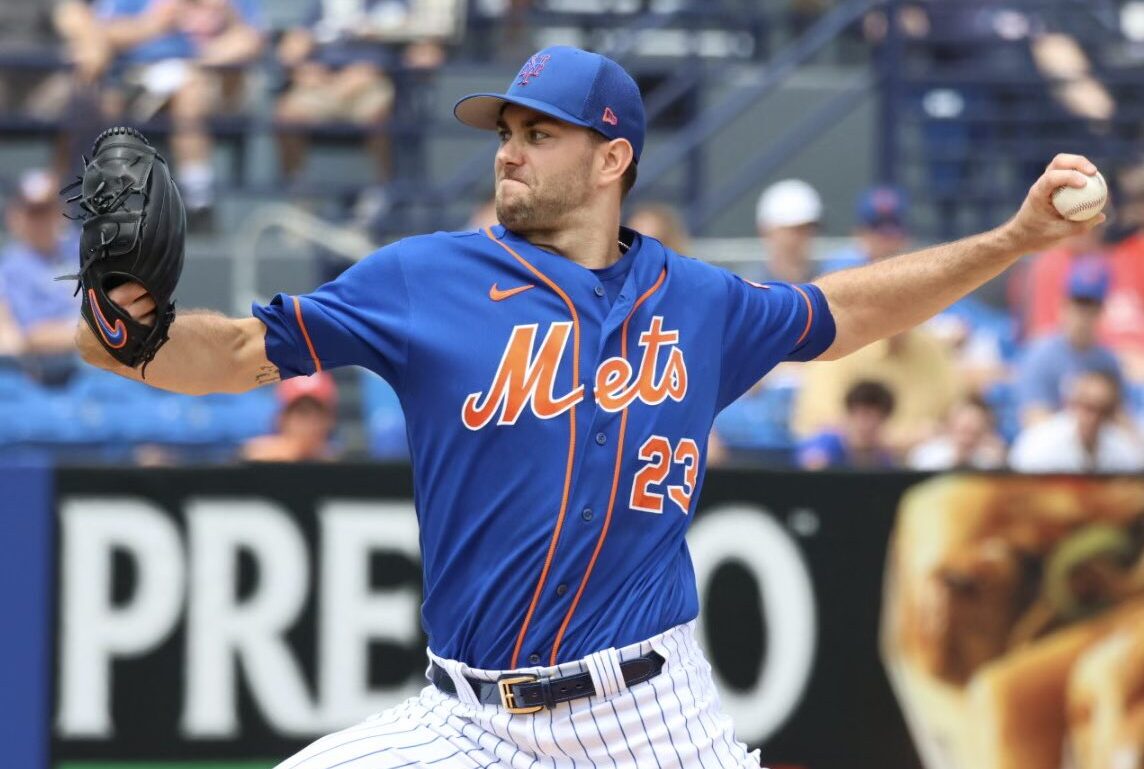
David Peterson. Photo by Ed Delany of MetsmerizedOnline
What Wasn’t Predictable?
The fact that all these hitters are performing so poorly is unexpected. When I wrote the article about the Mets’ big questions, I did not anticipate that the decline would be ubiquitous.
Additionally, I am surprised that Verlander and Scherzer have struggled this much. Despite what I said about Father Time, it’s hard to fathom two pitchers going from 1.75 and 2.29 ERAs to the largely ineffective pitching that we have seen from them. Verlander, in particular, is startling.
The biggest shocker of the season is how thoroughly David Peterson fell apart. He had a poor year in 2021 and struggled at the end of 2022. Still, an 8.08 ERA and four starts of eight with five or more earned runs allowed (and two more with four runs surrendered) was beyond what anyone would have possibly thought would happen.
There are other things not bouncing the Mets’ way, such as the seeming propensity of opposing defenders to suddenly become Gold Glovers when playing the Mets. The length of time Quintana has missed is unfortunate. Getting stuck with multiple early doubleheaders due to rain, especially with Scherzer suspended, was unlucky.
On the plus side, Francisco Álvarez‘s power stroke, framing ability, and chemistry with his pitchers as a 21-year-old rookie have been a pleasant surprise. Had Narváez not gone down, I think there is a decent chance Álvarez would have remained in the minors the entire season. The Mets insisted that his defense needed to improve, and I don’t think that would have changed.
Outcome Ranges
Overall, the Mets’ current performance is likely one of their worst expected outcomes when combining all the factors. There is generally a range of what can be expected from a team given the sum of its parts. 2022 was, in many ways, a 95th percentile outcome; many things broke the Mets’ way, making them think that they were very close to a championship if they would mostly run it back, especially offensively.
However, realistically, it was more likely than not that the team would regress to the mean, closer to a 50th-percentile outcome. Without any significant improvements, that 50th percentile was likely closer to an 85-to-90-win season than a 100-win one.
Eighty-five wins in a season is a .525 winning percentage, translating to 34.7 victories in 66 games; 90 wins is .556 or 37.0 wins. The Mets currently have 31 victories, which means they’re ostensibly only between 3.7 and 6.0 wins below what would have been an average season with this team thus far. That’s a lot, but it’s not outrageous.
If the Mets finish the season around the .500 mark, is it fair to say that it was completely out of left field? Given the questions from before the season, maybe there were simply too many assumptions made about 2022 being predictive.
If the Mets end up worse than .500, which is what they look like right now, then yes, this season is catastrophic and unpredictable. Still, there was much writing on the wall that the Mets ignored.
Perhaps the team can turn it around. However, we’ve been saying that for weeks now. Maybe this is just who the Mets are: an inexplicably underachieving team.
